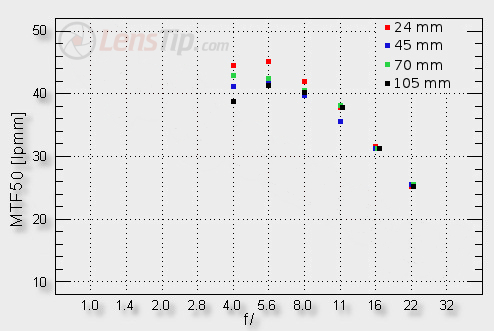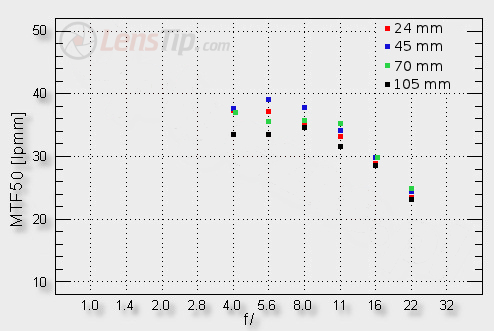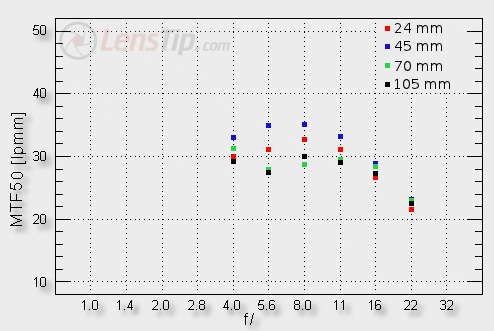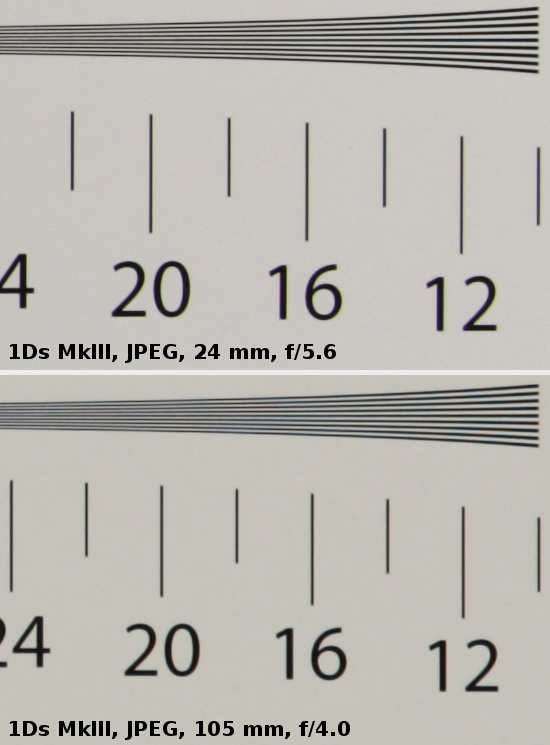Sigma A 24-105 mm f/4 DG OS HSM
4. Image resolution
Let’s check the performance of the Sigma 24-105 mm in the frame centre.

Please Support UsIf you enjoy our reviews and articles, and you want us to continue our work please, support our website by donating through PayPal. The funds are going to be used for paying our editorial team, renting servers, and equipping our testing studio; only that way we will be able to continue providing you interesting content for free. |
- - - - - - - - - - - - - - - - - - - - - - - - - - - - - - - - - - - - - - - - - - - - - - - -
At 24 mm its results are simply splendid. Already at the maximum relative aperture it gets near 44 lpmm and on slight stopping down it reaches 45 lpmm. These values are just slightly higher than those of the Canon and the Nikkor.
The 45-70 mm range provides a bit lower MTFs than those at 24 mm but still you can call them very good, even excellent. By f/4.0-5.6 the MTF50 values get to 42-43 lpmm – when it comes to a zoom lens you can hardly demand a better performance. The Sigma also compares favourably with its direct rivals. It is better than the Canon – just slightly so at 45 mm but that difference increases significantly at 70 mm. In the duel with the Nikkor there is a draw at 40-45 mm focal length but at 70 mm the Sigma slightly prevails.
All the lenses, described here, fared the worst at the longest focal length. It doesn’t mean, though, that the images, provided there, are of weak quality, quite the opposite in fact. The Sigma’s MTFs, even at the maximum relative aperture, rise to over 38 lpmm and such results are by several lpmm better than those of the Canon and the Nikkor.
It is clear that in the frame centre the Sigma fares very well, better than its brand-name opponents. The differences aren’t perhaps huge but still they remain measurable and quite unanimous.
Let’s check now the performance at the edge of the APS-C/DX sensor.

This time the 45 mm focal length is the best, with a bit weaker wide angle and the worst results at the longest focal length. Fortunately even there, at the maximum relative aperture, the image remains fully useful. Neither the Canon nor the Nikkor managed such a trick. Both those lenses at longer ends had to be stopped down to f/5.6 to become fully useful. Once again the Sigma is better than its immediate competitors. The maximum result the lens gets on the edge of the APS-C/DX sensor confirms it once again – the Sigma goes to 39 lpmm, the Canon and the Nikkor – to 38 lpmm.
Finally let’s analyze the performance on the edge of full frame.

Here again the 45 mm focal length is the best and its performance can be described as good. It would be difficult to complain about the wide angle either – even at the maximum relative aperture the MTFs reach 30 lpmm and they increase on stopping down. The performance at the longer end (the focal range from 70 to105 mm) is interesting, though. The maximum relative aperture results can be still considered decent there but on stopping down you notice a slight resolution decrease which returns to a sensible level near f/8.0. Such a performance is connected with a local maximum of the lateral chromatic aberration and a specific astigmatism performance.
As you see the Sigma shouldn’t be ashamed of its results on the very edge of the full frame sensor. If you are not especially demanding you can even say that it provides fully useful images at every focal length. You couldn’t say that much about the Nikkor 24-120 mm, which at longer focal lengths was simply weak (it had to be stopped down really significantly, to f/8.0-11, just to come near the decency level).
To sum up the Sigma showed a great performance in the frame centre, good on the edge of the APS-C/DX sensor and quite decent on the edge of full frame. No other 24-1?? mm class lens we’ve tested so far can boast of such a trick. Once again Sigma shows that they can produce good optics, not inferior even if compared to its brand-name rivals.
At the end we present crops taken from the centre of our testing chart; they were saved as JPEG files along with RAW files, used for the analysis above.
 |






